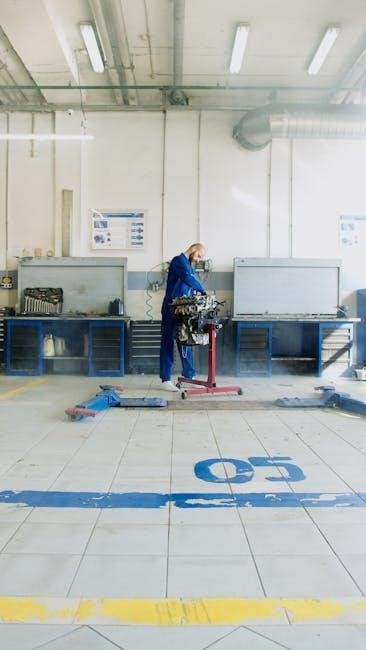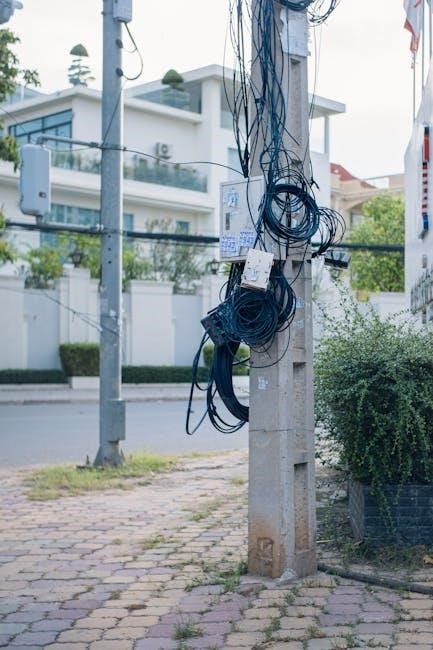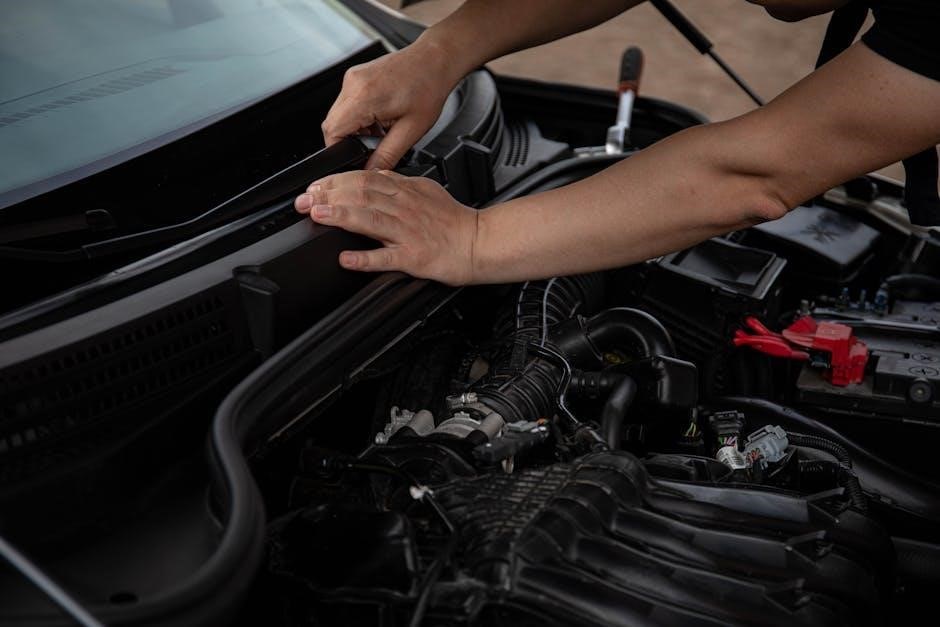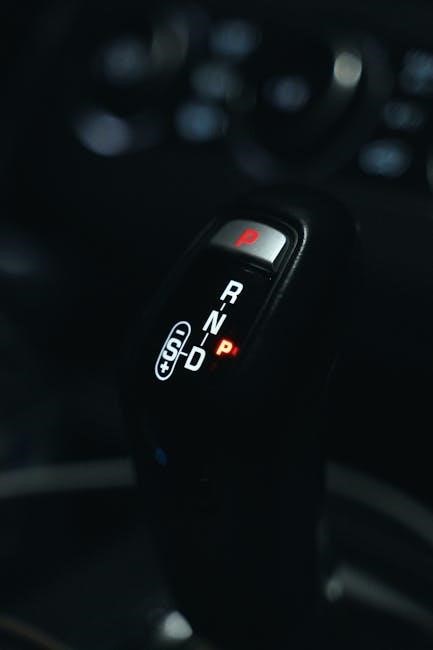Manual transmissions, while reliable, can develop issues like slipping clutches, gear shifting problems, fluid leaks, and unusual noises. Early detection and maintenance are crucial to prevent major repairs.
Overview of Common Problems
Manual transmissions often face issues like slipping clutches, gear shifting difficulties, and fluid leaks. These problems can arise from worn components, improper lubrication, or excessive wear. Slipping clutches occur when the clutch fails to engage properly, while gear shifting problems may stem from faulty synchronizers or damaged shift forks. Transmission fluid leaks are another common issue, often caused by worn seals or gaskets. Additionally, unusual noises such as grinding, ticking, or whining sounds can indicate internal damage or bearing failure. Addressing these issues early is crucial to prevent further damage and costly repairs.
Importance of Early Detection
Early detection of manual transmission issues is crucial to prevent minor problems from escalating into major repairs. Ignoring symptoms like slipping clutches or unusual noises can lead to costly damage. For instance, a worn clutch left unaddressed can damage the flywheel, requiring expensive replacements. Similarly, transmission fluid leaks, if not repaired promptly, can cause severe internal damage and even transmission failure. Regular checks and addressing issues early ensure smoother operation, reduce repair costs, and extend the lifespan of the transmission. Proactive maintenance is key to avoiding unexpected breakdowns and keeping your vehicle running efficiently.
Preventive Maintenance Tips
Regular maintenance is essential to prevent manual transmission issues. Check transmission fluid levels frequently and top them up as needed to ensure proper lubrication. Inspect seals and gaskets for signs of wear or leaks, addressing them before they cause fluid loss. Replace the clutch at the first sign of slippage to avoid further damage. Additionally, monitor gear engagement and address any sticking or grinding promptly. Schedule periodic inspections with a professional to identify potential problems early. By staying proactive, you can significantly reduce the risk of costly repairs and extend the lifespan of your transmission.

Slipping Clutch
A slipping clutch is a common issue where the clutch fails to engage properly, causing power loss during acceleration. It often results from wear, overheating, or improper adjustment.
Causes of a Slipping Clutch
A slipping clutch can arise from various factors. Prolonged wear and tear on the clutch disc is a primary cause, as it loses friction over time. Overheating the clutch, often due to aggressive driving or improper technique, can also lead to slippage. Additionally, incorrect clutch pedal adjustment or low clutch pedal free play can prevent full engagement. In some cases, contamination of the clutch components by oil or debris may reduce friction, causing the clutch to slip. These issues can significantly impact the performance and control of a manual transmission vehicle.
Symptoms of a Slipping Clutch
A slipping clutch often manifests through noticeable performance issues. Drivers may experience a lack of acceleration or engine RPMs rising without corresponding speed increases. The clutch pedal might feel spongy or loose, indicating poor engagement. Additionally, a burning smell may occur due to excessive heat from the slipping clutch. In some cases, grinding or unusual noises during gear shifts can signal a problem. These symptoms can worsen over time if left unaddressed, leading to further damage and potential failure of the clutch system.
Solutions for a Slipping Clutch
A slipping clutch can often be resolved by inspecting and replacing worn components. The clutch disc, pressure plate, or release bearing may need replacement if they show significant wear. Adjusting the clutch pedal or realigning the clutch assembly can also address the issue. In some cases, resurfacing the flywheel may be necessary to ensure proper engagement. Preventive measures include avoiding excessive riding of the clutch and ensuring the clutch pedal is fully disengaged during shifts. Regular maintenance and prompt repairs can prevent further damage and restore smooth operation;

Gear Shifting Problems
Gear shifting issues often arise from worn synchronizers, faulty clutch engagement, or low transmission fluid levels. Difficulty shifting, grinding noises, or gears sticking are common symptoms requiring attention.
Difficulty Shifting Gears
Difficulty shifting gears is a common issue in manual transmissions, often caused by a worn clutch or failing synchronizers. Low transmission fluid levels can also contribute, as proper lubrication is essential for smooth gear engagement. Symptoms include grinding noises, hesitation, or the gear shifter feeling stiff. If left unaddressed, this can lead to further damage, such as damaged gear teeth or synchro rings. Regular maintenance, such as checking transmission fluid and inspecting the clutch, can help prevent these issues. Addressing problems early ensures smoother shifting and extends the lifespan of the transmission system.
Gears Sticking or Not Engaging
Gears sticking or not engaging is a frustrating issue that can hinder smooth driving. This problem often stems from worn synchronizers, damaged gear teeth, or insufficient transmission fluid. Additionally, dirt or debris in the gearbox can interfere with proper gear engagement. If gears fail to engage fully, it may result in grinding noises or difficulty shifting. Addressing this issue promptly is crucial, as prolonged neglect can lead to more severe damage, requiring costly repairs. Regular maintenance, including fluid checks and component inspections, helps prevent gears from sticking and ensures optimal transmission performance.
Grinding Noises During Shifting
Grinding noises during shifting are a common indicator of manual transmission issues. This sound typically occurs when gears fail to engage smoothly, often due to worn clutch components or synchronizer damage. If the clutch is not fully disengaging, it can cause gears to grind against each other. Additionally, low transmission fluid levels or contamination can exacerbate the problem. Ignoring grinding noises can lead to further damage, such as worn gear teeth or damaged bearings. Addressing this issue promptly is essential to prevent costly repairs and ensure smooth gear transitions. Regular maintenance can help identify and resolve such problems early.
Gears Popping Out
Gears popping out, or jumping out of gear, is a concerning issue in manual transmissions. This occurs when the gears fail to stay engaged, often due to worn synchronizers or damaged gear teeth. Increased wear on the transmission components can lead to this problem, especially if the clutch is not functioning properly. Driving in heavy traffic or frequent shifting can exacerbate the issue. If left unaddressed, gears popping out can lead to further damage, such as stripped gears or transmission failure. It is crucial to inspect the transmission and replace worn parts promptly to ensure reliable performance and safety.

Transmission Fluid Leaks
Transmission fluid leaks are a common issue, often caused by worn seals or gaskets. They can lead to serious damage if not addressed promptly, requiring costly repairs.
Identifying Transmission Fluid Leaks
Transmission fluid leaks can be identified by inspecting for reddish or brownish fluid under the vehicle. Check the transmission pan gasket, drain plug seal, and input/output shaft seals for wear or damage. Regularly monitoring fluid levels and looking for stains on the ground can help detect leaks early. Addressing these issues promptly is crucial to prevent further damage to the transmission system.
Causes of Transmission Fluid Leaks
Transmission fluid leaks are often caused by worn-out seals and gaskets, which deteriorate over time due to heat and pressure. Damaged or loose connections, such as the transmission pan gasket or drain plug, can also lead to leaks. In addition, high mileage and lack of maintenance can cause seals to fail, allowing fluid to escape. Addressing these issues promptly is essential to prevent further damage to the transmission system and ensure optimal performance.
Consequences of Untreated Leaks
Untreated transmission fluid leaks can lead to severe damage, including low fluid levels, which reduce lubrication and cause increased wear on gears and bearings. Over time, this can result in overheating, accelerated component failure, and costly repairs. Prolonged fluid loss may also cause corrosion and contamination, further compromising the transmission’s integrity. If left unaddressed, leaks can lead to complete transmission failure, requiring extensive and expensive overhauls or replacements. Regular checks and prompt repairs are essential to prevent these consequences and ensure the longevity of the manual transmission system.
Repairing Transmission Leaks
Repairing transmission leaks often involves identifying and replacing worn or damaged seals, gaskets, or pan bolts. A mechanic may need to dismantle the transmission to access internal components. In some cases, resealing the transmission pan or replacing the torque converter may be necessary. It’s crucial to use high-quality replacement parts and follow proper torque specifications to ensure a leak-free seal. DIY repairs can be challenging due to the complexity of transmission systems, so professional assistance is frequently recommended to avoid further damage. Timely repairs can prevent costly overhauls and extend the transmission’s lifespan.

Unusual Noises
Unusual noises, such as grinding, ticking, or whining, often indicate underlying issues like worn bearings, damaged gears, or low fluid levels. Addressing these sounds promptly prevents major repairs.
Grinding Sounds
Grinding sounds during gear shifts are often caused by worn or damaged synchronizers, clutch issues, or improper engagement. These noises can indicate failing components within the transmission. Ignoring them may lead to costly repairs. Regular maintenance and inspections can help identify such problems early. Grinding noises should be addressed promptly to prevent further damage to gears and bearings. If left unchecked, they can escalate into more severe issues, requiring extensive overhauls. Professional diagnosis is recommended to determine the root cause and implement effective solutions.
Ticking or Clicking Noises
Ticking or clicking noises in a manual transmission often arise from low fluid levels, worn bearings, or damaged gear components. These sounds can signal early-stage wear and tear. If the transmission is not properly lubricated, moving parts may generate these noises. In some cases, loose or faulty gear teeth can also produce clicking sounds. It’s essential to inspect the fluid levels and condition, as well as check for any mechanical damage. Addressing these issues promptly can prevent them from escalating into more serious problems requiring costly repairs or even transmission replacement.
Whining or Howling Sounds
Whining or howling noises from a manual transmission typically indicate issues with the gears or bearings. These sounds often occur due to worn or damaged gear teeth, improper lubrication, or misaligned components. The pitch of the noise may vary with speed or gear engagement. If left unaddressed, these problems can lead to gear failure or complete transmission breakdown. Regular lubrication checks and inspections of gear and bearing conditions are vital to prevent such issues. Early intervention can help avoid costly and time-consuming repairs down the line.
Bearing Noises
Bearing noises in a manual transmission are often characterized by grinding, growling, or humming sounds. These noises typically arise from worn or damaged bearings within the gearbox. Over time, lack of lubrication or excessive wear can cause bearings to degrade. If ignored, this can lead to catastrophic failure, requiring expensive repairs. Regular transmission fluid checks and inspections are essential to identify bearing issues early. Addressing these problems promptly helps maintain smooth operation and prevents further damage to transmission components. Bearings play a critical role in gear movement, so their failure can severely impact vehicle performance.

Clutch-Related Issues
Clutch-related issues often include slipping, sticking, or dragging, which can lead to poor gear engagement and potential transmission damage if left unaddressed.
Sticking Clutch
A sticking clutch occurs when the clutch fails to disengage properly, causing the engine to stay connected to the transmission. This can lead to difficulty shifting gears and unintended acceleration. Common causes include worn or warped clutch components, incorrect clutch pedal adjustment, or hydraulic system malfunctions. Symptoms often involve the clutch pedal feeling stuck or rigid, making it hard to press or release smoothly. If left untreated, a sticking clutch can result in increased wear on transmission components and potentially lead to more severe mechanical failures down the line.
Dragging Clutch
A dragging clutch occurs when the clutch fails to fully disengage, causing the engine to remain partially connected to the transmission. This can result in grinding noises when shifting gears and increased wear on clutch components. Common causes include misadjusted clutch pedals, worn or damaged clutch facings, or oil contamination on the clutch disc. Symptoms often involve difficulty shifting into gear and a spongy or unresponsive clutch pedal. If ignored, a dragging clutch can lead to premature wear of the clutch and related components, necessitating costly repairs. Regular inspection and adjustment of the clutch system are essential to prevent this issue.
Clutch Pedal Problems
Clutch pedal issues can significantly affect the performance of a manual transmission. Common problems include a spongy or soft pedal feel, which often indicates air in the hydraulic system or worn-out components. A hard-to-press pedal may result from a malfunctioning clutch master or slave cylinder. In some cases, the pedal may stick or not return to its resting position, usually due to dirt or debris in the pedal mechanism. Addressing these issues promptly is crucial, as they can lead to further damage, such as clutch failure or difficulty shifting gears. Regular maintenance, including fluid checks and component inspections, can help prevent these problems.
Gear engagement issues often stem from worn synchronizers or damaged gear teeth, causing grinding or failure to engage gears smoothly. Regular lubrication and inspections are essential. A transmission not engaging gears can stem from low fluid levels, a faulty clutch, or worn-out components like synchronizers or gear teeth. Symptoms include difficulty shifting, grinding noises, or the gear failing to catch. If the clutch doesn’t fully disengage, it can prevent proper gear engagement. Electrical issues, such as a malfunctioning sensor or solenoid, may also cause problems. Ignoring these signs can lead to further damage, requiring costly repairs. Regular fluid checks and inspections can help identify issues early, ensuring smooth gear engagement and optimal transmission performance. Addressing these problems promptly is crucial to avoid severe transmission failure. Scratching or grinding noises when engaging gears often indicate worn or damaged components within the transmission. Common causes include worn synchronizers, damaged gear teeth, or a faulty clutch. If the clutch does not fully disengage, it can cause gears to grind during shifting. Additionally, misaligned or damaged gear shafts may lead to these noises. Ignoring these symptoms can result in further damage, such as stripped gears or synchronization issues. Addressing the problem early is crucial to prevent costly repairs and ensure smooth gear engagement. Regular inspections and timely replacements of worn parts can help maintain proper transmission function. Failure to stay in gear is a concerning issue that can occur due to worn or damaged transmission components. This problem often arises from worn-out synchronizers or a faulty clutch, which prevents gears from properly engaging. In some cases, bent or misaligned gear shafts can cause gears to slip out of position. If left unaddressed, this can lead to sudden disengagement while driving, posing safety risks. Regular inspections and timely replacements of worn parts are essential to resolve the issue and ensure reliable gear engagement. Addressing this problem early is critical to avoid further damage and maintain smooth transmission operation. Less common issues include gear popping out, double engagement, transmission bearing failure, and synchronization problems, which can cause unpredictable behavior and require specialized repairs. Gear popping out, or jumping gears, occurs when a gear disengages unintentionally while driving. This can happen due to worn or damaged synchronizers, a bent shift fork, or low transmission fluid levels. It may also result from improper shifting techniques or excessive wear on gear teeth. When this issue arises, it can lead to loss of control or difficulty maintaining speed. Addressing the problem promptly is essential, as it can escalate to more severe transmission damage. Repairing this often requires replacing faulty components, which may involve specialized tools and expertise. Regular maintenance can help prevent such issues from developing. Double engagement or gear selection issues occur when the transmission mistakenly selects more than one gear simultaneously or fails to engage the correct gear. This can lead to unexpected shifts, grinding noises, or difficulty accelerating. Causes often include worn or damaged synchronizers, faulty gear position sensors, or misaligned gear components. Improper clutch operation or excessive wear on shift forks and collars can also contribute. If left unresolved, this may result in severe damage to transmission internals. Professional diagnosis and repair are typically required to identify and replace the faulty components, ensuring smooth gear engagement and proper transmission function. Transmission bearing failure is a critical issue that can lead to severe operational problems. Bearings support moving parts within the gearbox, ensuring smooth gear rotation and alignment. Over time, wear, overheating, or contamination can cause bearings to degrade, resulting in noisy operation, vibrations, and difficulty shifting gears. If ignored, failed bearings can damage surrounding components, requiring costly repairs. Regular lubrication and inspections are essential to prevent premature bearing failure. Replacing worn bearings promptly can help maintain transmission efficiency and prevent further complications down the road, ensuring optimal performance and longevity of the manual transmission system. Synchronization issues occur when gear engagement becomes inconsistent, often due to worn synchronizers or improper clutch operation. This can lead to grinding sounds, difficulty shifting, and gear hesitation. Over time, high mileage or aggressive driving may exacerbate these problems. If left unaddressed, synchronization issues can cause further damage to gears and bearings, leading to costly repairs. Regular clutch adjustments and synchronizer inspections are key to preventing these problems. Addressing synchronization issues early ensures smoother gear transitions and maintains the overall performance of the manual transmission system. Proper driving techniques and timely maintenance are essential to avoid complications. Regular transmission fluid checks, inspecting seals and gaskets, and replacing worn clutch components are essential. Professional diagnostic tools help identify issues early, ensuring proper maintenance and preventing major repairs. Regular transmission fluid checks are vital for maintaining manual transmission health. Low or degraded fluid can cause slipping gears, grinding noises, and premature wear. Always use the specified fluid type and level recommended by the manufacturer. Check the fluid level using the dipstick, ensuring it’s within the designated range. If the fluid appears dirty or discolored, replace it promptly. Regular fluid changes, typically every 30,000 to 60,000 miles, help prevent contamination and maintain smooth gear engagement. Consistent fluid maintenance can significantly extend the lifespan of your manual transmission and prevent costly repairs down the road. Inspecting seals and gaskets in a manual transmission is essential to prevent fluid leaks, which can lead to severe damage. Over time, seals and gaskets may wear out or crack, allowing transmission fluid to escape. Regularly check the input and output shaft seals, as well as the pan gasket, for any signs of leakage or damage. If leaks are detected, replace the faulty components immediately to avoid further complications. Properly sealing the transmission ensures optimal performance and prevents costly repairs related to fluid loss and component failure. Consistent inspections can help maintain the integrity of your manual transmission system. Replacing worn clutch components is critical to ensure smooth gear transitions and prevent further damage to the transmission. A slipping or sticking clutch often indicates worn friction plates or a faulty pressure plate. If ignored, these issues can lead to complete clutch failure, requiring costly repairs. When replacing clutch components, it’s essential to use high-quality parts and follow proper installation procedures. Additionally, the flywheel should be inspected for wear and resurfaced if necessary. Regular clutch maintenance can extend the life of your manual transmission and maintain optimal driving performance. Addressing worn components early prevents more severe problems down the road. Professional diagnostic tools are essential for accurately identifying manual transmission issues. Mechanics often use advanced scan tools to monitor transmission sensors and detect fault codes. Pressure testing kits can identify internal leaks or faulty seals. Endoscopic cameras allow visual inspection of gears and bearings without disassembly. These tools enable precise diagnostics, reducing guesswork and saving time. Regular use of diagnostic equipment helps catch issues early, preventing costly repairs. Investing in professional tools ensures accurate assessments and effective solutions for manual transmission problems, making them indispensable for both professionals and skilled DIY enthusiasts. They provide clarity and efficiency in troubleshooting complex transmission systems. Seek professional help for severe transmission damage, persistent fluid leaks, unusual noises, or gears failing to engage. Addressing these issues promptly prevents further damage and ensures safety. Severe transmission damage often manifests through persistent grinding noises, fluid leaks, or gears failing to engage. If you notice unusual vibrations, difficulty shifting, or the transmission slipping frequently, it indicates critical wear. A burning smell or metallic debris in the fluid are also red flags. Ignoring these signs can lead to complete system failure, requiring costly overhauls. If you observe multiple symptoms simultaneously, seek professional help immediately to assess and repair the damage before it escalates further. Complex manual transmission repairs often involve internal components like gears, bearings, or synchronizers. These parts are deeply embedded, requiring disassembly and specialized tools. Issues like gear tooth wear or bearing failure demand precise machining or replacement. DIY attempts can worsen damage, highlighting the need for professional expertise. Advanced diagnostic tools are essential to pinpoint faults accurately. Such scenarios underscore the importance of skilled mechanics, as improper repairs can lead to further breakdowns and increased costs. Certain manual transmission issues require immediate attention to prevent further damage. For example, a sudden gear failure or excessive fluid leak can quickly escalate, leading to costly repairs if not addressed promptly. Time-sensitive repairs often involve replacing worn-out components or sealing leaks before they cause systemic damage. Delays can result in the need for a complete transmission overhaul, which is both time-consuming and expensive. Acting swiftly ensures the longevity and performance of the transmission, avoiding prolonged downtime and higher repair costs. After repairing manual transmission issues, regular maintenance is essential to ensure longevity and prevent future problems. This includes checking transmission fluid levels, inspecting for leaks, and monitoring clutch and gear performance. Proper driving techniques, such as smooth shifting and avoiding riding the clutch, can also reduce wear. Scheduled maintenance, like replacing the clutch or synchronizers as needed, helps maintain optimal performance. By following a consistent upkeep routine, drivers can extend the life of their transmission and avoid costly repairs down the road.
Gear Engagement Issues
Transmission Not Engaging
Scratching or Grinding When Engaging Gears
Failure to Stay in Gear

Less Common Problems
Gear Popping Out
Double Engagement or Gear Selection Issues
Transmission Bearing Failure
Synchronization Issues

Maintenance and Repair Tips
Regular Transmission Fluid Checks
Inspecting Seals and Gaskets
Replacing Worn Clutch Components
Professional Diagnostic Tools

When to Seek Professional Help
Recognizing Severe Transmission Damage
Complex Repair Scenarios
Time-Sensitive Repairs
Post-Repair Maintenance
